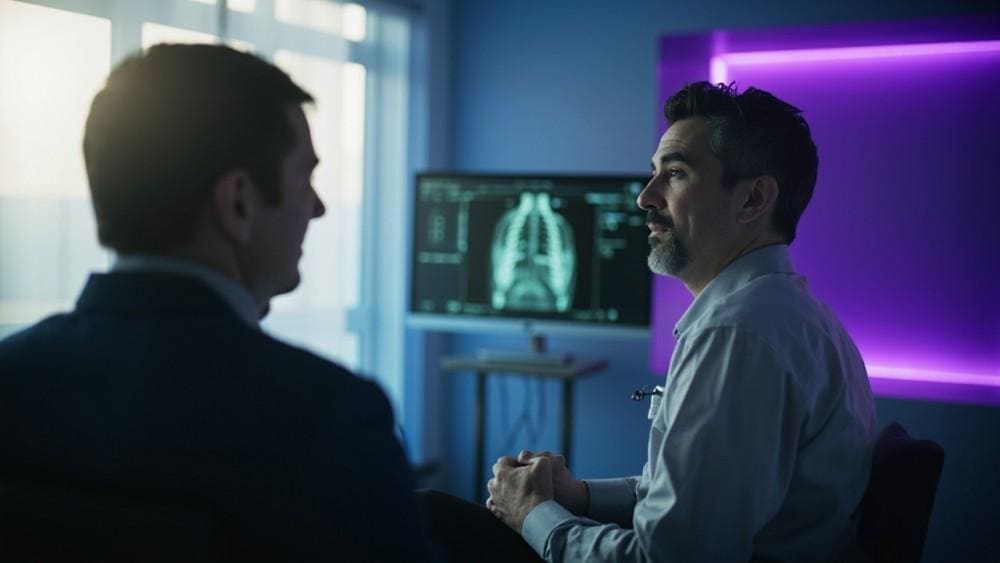Introduction to Annular Fissures
Quick Insights
An annular fissure is a tear in the outer layer of a spinal disc, frequently leading to localized back pain. Medical research confirms prompt diagnosis supports conservative management and improved recovery outcomes.
Key Takeaways
- Annular fissures can develop from age, repetitive strain, injury, or poor posture, weakening disc structure.
- Typical symptoms include pain, radiating discomfort, tingling, and reduced mobility—but some people may have no symptoms.
- Diagnosis commonly involves medical history, physical exam, and advanced imaging such as MRI or CT to pinpoint disc tears.
- Early treatment options often succeed; persistent symptoms may require minimally invasive or surgical interventions for relief.
Why It Matters
Living with an annular fissure can make everyday tasks miserable and increase feelings of stress or frustration. Recognizing symptoms early empowers you to seek effective care, improve quality of life, and keep doing the things you love without constant pain.
As a board-certified physician in Pain Medicine and Physical Medicine & Rehabilitation with over two decades of experience, I’ve seen how annular fissures can disrupt daily life for Houstonians seeking answers—and genuine relief—in my practice. As a board-certified interventional pain physician, my focus on the full spectrum of spine health conditions has shown me how early action makes a difference.
An annular fissure is a small but significant tear in the tough outer layer of your spinal disc, the annulus fibrosus. This spine injury can trigger a painful inflammatory cascade and, left untreated, may lead to nerve symptoms or worsen spinal degeneration over time.
Because these disc tears often start subtly—sometimes with only mild back pain—they’re frequently missed or misdiagnosed. Prompt recognition and management make a dramatic difference, as most annular fissures respond well to conservative treatments—clinical guidance shows that early intervention can prevent chronic pain and disability for the majority of patients.
If you’ve struggled with lingering back pain, or wonder about the best way forward, let me share what works—and what truly matters—and guide you toward real solutions.
Used source: https://www.ncbi.nlm.nih.gov/books/NBK538315/
Causes and Diagnosis of Annular Fissures

Causes of Annular Fissures
Annular fissures—also called disc tears—develop when the tough outer layer of a spinal disc, the annulus fibrosus, weakens or splits. In my 20 years of treating spine conditions in Houston, I’ve seen these tears arise from a combination of age, lifestyle, and injury.
The most common causes of annular fissures include:
- Age-related degeneration: Natural wear and tear weakens the annulus over time, especially in the lumbar spine.
- Repetitive stress: Frequent bending, lifting, or twisting—common in active Houston lifestyles or certain jobs—places ongoing strain on discs.
- Trauma or injury: Sudden impacts, such as falls or car accidents, can cause immediate disc tears.
- Poor posture: Prolonged sitting or improper lifting techniques increase disc pressure, raising the risk of fissures.
- Smoking: Nicotine reduces blood flow to spinal discs, impairing their ability to heal and resist injury.
Less commonly, genetic predisposition or metabolic diseases can make discs more vulnerable. Houston’s humid climate and physically demanding occupations may also contribute to higher risk locally. Learn more about degenerative disc disease treatment options and how they often relate to annular fissure formation.
Research confirms that disc degeneration is a leading factor in annular fissure formation, often preceding disc herniation or chronic back pain. For more on the link between disc degeneration and fissures, see this Mayo Clinic overview of disc and tissue degeneration.
My experience as a master instructor has shown that understanding these risk factors is crucial for both prevention and early intervention. For additional background, see our comprehensive guide to L5-S1 bulging disc, which often includes discussion of annular fissure lumbar injuries.
Diagnosis Techniques
Diagnosing an annular fissure requires a careful, stepwise approach. In my Houston clinic, I start with a detailed history and physical exam, then use advanced imaging as needed.
Key diagnostic steps include:
- Medical history: I ask about pain patterns, injuries, and lifestyle factors.
- Physical examination: Checking for tenderness, nerve changes, and range of motion helps localize the problem.
- X-rays: Useful for ruling out bone issues, but do not show disc tears.
- MRI: The gold standard for visualizing annular fissures, disc bulges, and herniations. However, not all fissures are visible on MRI.
- CT scan: Offers detailed images of bone and some disc changes, especially in complex cases.
- Discogram: In select cases, I use this test to pinpoint painful discs by injecting contrast dye.
Different fissure types—paracentral, foraminal, or central annular fissures—may require tailored imaging strategies. As someone who trains other physicians, I emphasize that clinical expertise is essential, since imaging alone can miss subtle tears. If you’re considering professional back care, our back pain service offers comprehensive diagnostic assessment in Houston.
For more on diagnostic accuracy and imaging limitations, review this NCBI clinical guidance on disc evaluation and the Cleveland Clinic’s summary of disc imaging.
In Houston, patients can expect a thorough, personalized evaluation to ensure the right diagnosis and treatment plan. To understand more about how imaging reveals disc injuries, read about L5-S1 herniated disc surgery and its connection to annular fissure meaning.
Symptoms of Annular Fissures

Common Symptoms of Annular Fissure
An annular fissure is a tear in the disc’s outer layer that can trigger pain, nerve symptoms, or sometimes no symptoms at all.
The most common annular fissure symptoms I see in my practice include:
- Localized pain: Sharp or aching pain at the site of the fissure, often in the lower back.
- Radiating pain: Discomfort spreading to the buttocks, hips, or legs if nerve roots are irritated.
- Muscle weakness: Nerve involvement can cause weakness or tingling in the legs.
- Limited range of motion: Stiffness or difficulty bending and twisting.
- Pain with movement: Symptoms worsen with activities like lifting, sitting, or twisting.
These symptoms result from the inflammatory cascade triggered by disc tears, sometimes leading to nerve compression. Not everyone with an annular fissure experiences symptoms—some cases are found incidentally on imaging. Explore emergency symptoms of a herniated disc to know when urgent care is needed.
Research shows that disc tears can mimic herniated disc symptoms, making accurate diagnosis essential. For more on symptom patterns, see this Healthline guide to disc and nerve pain.
If you notice any of these symptoms, review the next section on when to seek medical attention.
When to Seek Medical Attention
Certain annular fissure symptoms require immediate attention from a physician:
- Loss of bladder or bowel control
- Progressive leg weakness or numbness
- Sudden inability to move part of your body
If you experience any of these, contact a physician or seek emergency care right away. These may signal serious nerve involvement. For more details, see this NHS overview of emergency disc symptoms.
It’s important to recognize the signs and seek answers—especially if you experience progressive spinal fissure symptoms or severe cases of annular fissure lumbar spine issues. Learn more about the S1 nerve root and its symptoms in context with annular fissuring.
Treatment Options for Annular Fissures

Non-Surgical Treatment Options
Most annular fissures respond well to non-surgical treatment, especially when addressed early. In my experience, these conservative options form the foundation of care:
- Pain medication (NSAIDs): Reduce inflammation and pain; best for short-term use.
- Physical therapy: Customized exercises strengthen spinal support muscles and improve flexibility.
- Hot/cold therapy: Alternating heat and cold packs can ease pain and reduce swelling.
- Pain relief patches: Topical medications like lidocaine patches target localized pain.
- Lifestyle modification: Improving posture, quitting smoking, and avoiding heavy lifting support disc healing.
These approaches are supported by clinical guidelines and research, including the UpToDate recommendations for conservative disc care.
Through my training in pain medicine, I tailor these treatments to each patient’s needs, often achieving significant relief without surgery. For practical advice, explore herniated disc exercises that may support annular fissure healing.
Minimally Invasive Procedures for Annular Fissure
When conservative care isn’t enough, I consider minimally invasive procedures. These options target the source of pain with less risk and downtime than surgery:
- Epidural steroid injections: Deliver anti-inflammatory medication directly to the affected area, reducing nerve irritation.
- Discseel® Procedure: This innovative, non-surgical treatment uses a biologic fibrin sealant to repair damaged discs and stimulate natural healing. Having performed hundreds of Discseel® procedures as Houston’s first master instructor, I’ve seen an 82% success rate—substantially higher than spinal fusion’s average. To learn more, visit the Discseel® procedure page for Dallas and Houston patients.
- Intradiscal biacuplasty: Uses radiofrequency energy to disrupt pain signals within the disc, ideal for chronic discogenic pain.
Each procedure has specific indications and benefits. I help patients choose based on their anatomy, prior treatments, and goals. For comparative outcomes and more details, see this systematic review of minimally invasive disc treatments.

The Discseel® Procedure offers an innovative solution for select patients—those interested can read more about the science and outcomes of Discseel® to see if it’s a fit in their care plan.
See if you’re a candidate for minimally invasive annular fissure relief at Performance Pain and Sports Medicine in Houston. As always, our Houston location offers easy access for local patients seeking help for annular fissure lumbar or central annular fissure conditions.
Surgical Options for Annular Fissure
Surgery is reserved for severe cases—typically when non-surgical and minimally invasive treatments have failed, or when there’s neurological compromise.
- Microdiscectomy: Removes the herniated disc portion pressing on nerves.
- Spinal fusion: Stabilizes the spine by joining two or more vertebrae, used for instability or multiple disc injuries.
Surgical intervention carries higher risks and longer recovery. I recommend it only when absolutely necessary, after exhausting other options. Research shows that while surgery can relieve symptoms, outcomes vary and complications are possible. For more on surgical efficacy, review this NCBI summary of surgical outcomes for disc conditions.
Always consult a spine specialist in Houston to discuss the full spectrum of annular fissure treatments and find the best path for your situation. To explore other nuanced spinal conditions like disc bulge with annular fissure, see our in-depth educational articles.
Our Approach to Patient Care

Patient experiences are at the heart of everything I do as a physician specializing in spine care. After 20 years of helping patients with annular fissures and related disc injuries, I know that trust and transparency are essential for successful outcomes.
My approach is rooted in evidence-based medicine, but also in listening closely to each patient’s story. I believe in offering a full spectrum of options—from conservative therapies to advanced, minimally invasive procedures—so you can make informed decisions about your care. Managing lumbar degenerative disc disease is just one example of how modern strategies help patients regain movement and confidence.
As someone who trains physicians nationally in the Discseel® Procedure, I am committed to maintaining the highest standards of safety and innovation. Every treatment plan is tailored to your unique needs, with a focus on restoring function and quality of life.
If you’re seeking answers about annular fissure symptoms or treatment, know that my practice is dedicated to providing clear guidance and compassionate support every step of the way.
Annular Fissure Treatment in Houston
Houston’s diverse and active community faces unique challenges when it comes to spine health. The city’s humid climate and physically demanding jobs can contribute to increased risk for annular fissures and other disc injuries.
As the first physician to bring the Discseel® Procedure to Houston, I’ve seen firsthand how local patients benefit from advanced, minimally invasive options. Research shows that early intervention and tailored care are especially important in a city where back pain can impact both work and daily life.
My clinic is committed to providing comprehensive evaluation and treatment for annular fissures, drawing on both my experience and the latest medical guidelines. If you’re in Houston and struggling with back pain, I invite you to explore your options and see if a personalized approach can help you return to the activities you love.
*This content reflects current medical guidelines and Dr. Wiederholz’s 20+ years of clinical experience.*
Conclusion
After 20 years of treating spine conditions and pioneering regenerative treatments in Houston, I know that an annular fissure can disrupt your life—but early diagnosis and a tailored, evidence-based approach make a real difference. Most patients benefit from conservative care, while others may need advanced options like minimally invasive procedures or, in rare cases, surgery. As Houston’s first Discseel® provider and a master instructor, I offer specialized expertise alongside a full spectrum of treatments to help you regain comfort and mobility.
If you’re struggling with back pain or have questions about annular fissure treatment in Houston, I invite you to see if you are a candidate for the Discseel® procedure—or explore other options that fit your needs. My commitment is to provide the highest standard of care, grounded in research and experience, so you can return to the activities you love. Contact us for a consultation and discover the most appropriate treatment for your annular fissure lumbar or central disc protrusion with annular fissure concerns.
*This article is for educational purposes only and should not be used as a substitute for professional medical advice, diagnosis, or treatment. Always seek the advice of your physician or other qualified healthcare provider with any questions you may have regarding a medical condition or treatment options. Never disregard professional medical advice or delay in seeking it because of something you have read in this article.*
Frequently Asked Questions
What is an annular fissure, and how does it cause back pain?
An annular fissure is a small tear in the tough outer layer of a spinal disc, called the annulus fibrosus. This tear can trigger an inflammatory cascade, leading to localized pain, nerve irritation, or even radiating symptoms. Not all fissures cause pain, but when they do, prompt diagnosis and treatment are important for recovery.
Where can I find advanced annular fissure treatment in Houston?
You can find comprehensive annular fissure care—including conservative, minimally invasive, and surgical options—at specialized spine clinics in Houston. As the city’s first Discseel® provider, my clinic offers both established and advanced treatments tailored to your needs. Always consult a board-certified physician to determine the best approach for your specific condition.
What are the most effective non-surgical treatments for annular fissures?
The most effective non-surgical treatments include pain medications (like NSAIDs), physical therapy, hot/cold therapy, and lifestyle modifications such as improving posture and quitting smoking. Research shows that most annular fissures heal with these conservative measures, especially when started early. For more details, see this Mayo Clinic overview of disc and tissue degeneration.

















